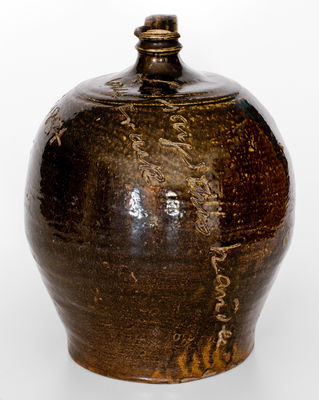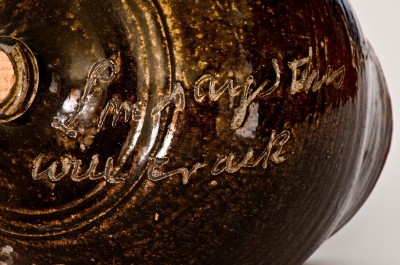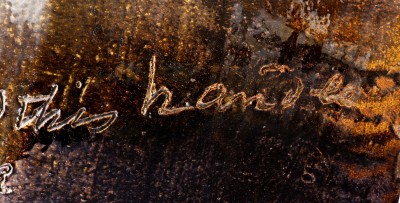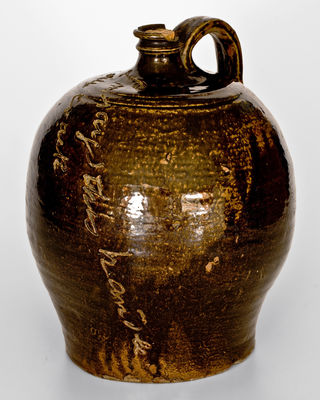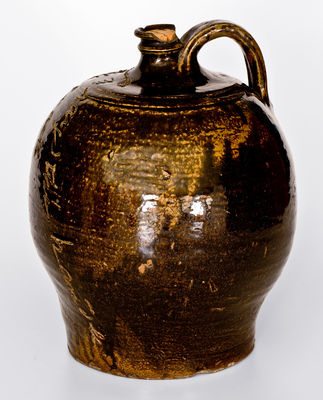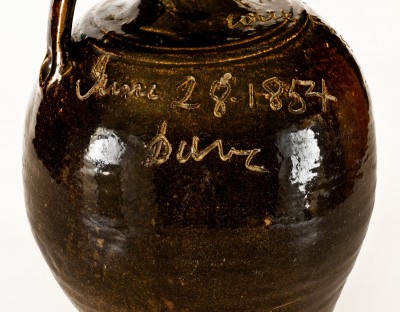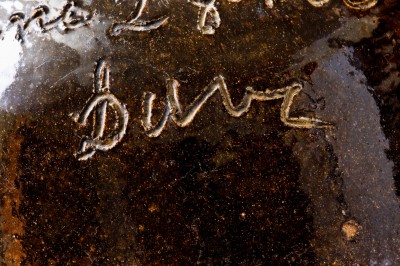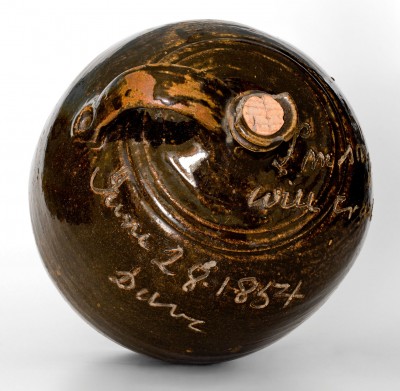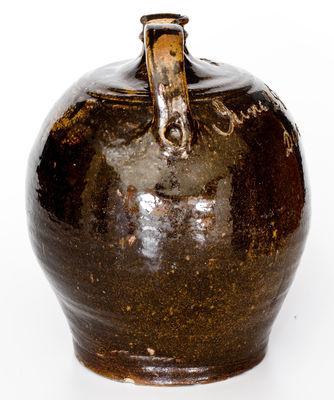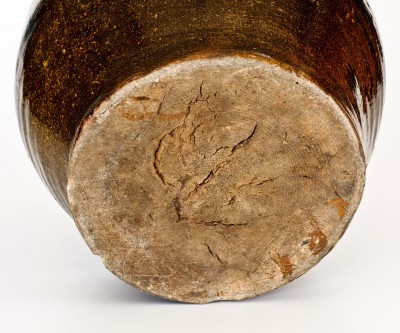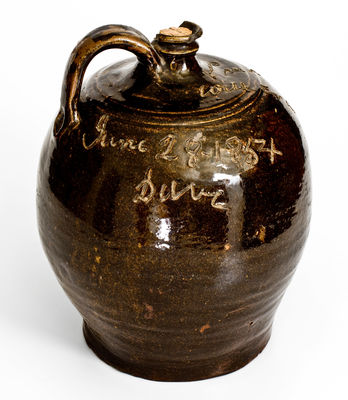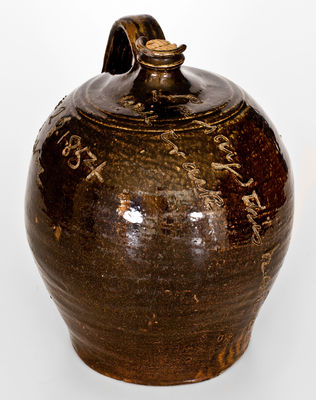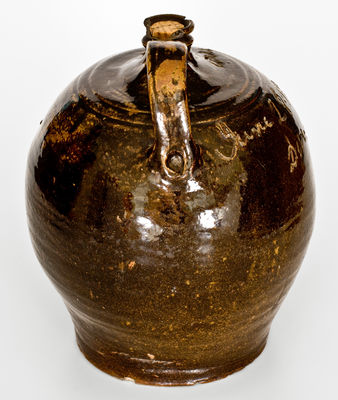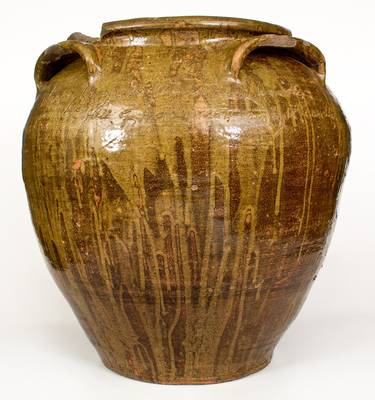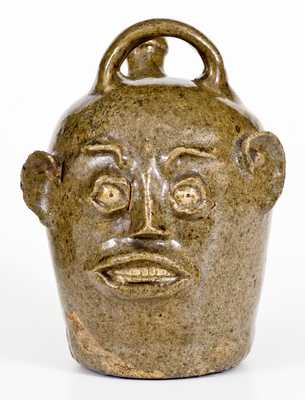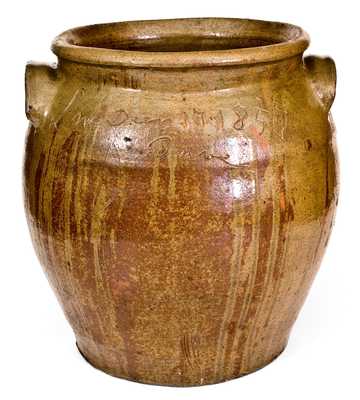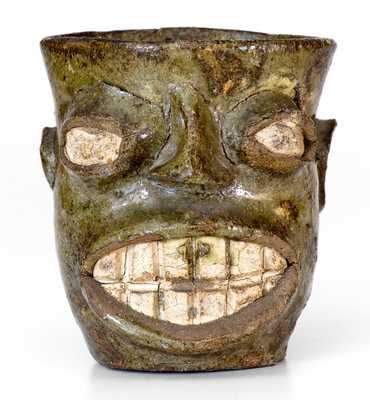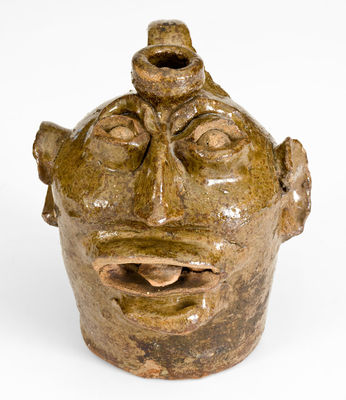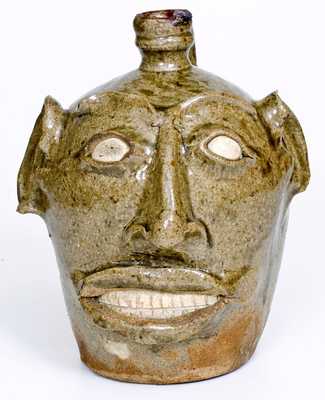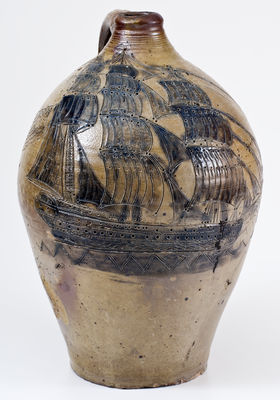Highly Important Three-Gallon Alkaline-Glazed Stoneware Jug, Incised "Lm says this handle will crack," Signed and Dated "Dave / June 28. 1854," David Drake at Lewis Miles' Stony Bluff Manufactory, Edgefield District, SC, 1854, bulbous jug with tooled shoulder, distinctive tiered spout, and thin strap handle with depressed lower terminal, the surface covered in a glossy, olive-brown alkaline glaze with light green mottling throughout. Vertically incised from the shoulder to the base of the jug with the inscription, "Lm says this handle / will crack." This inscription is deeply-scrawled and unusually large in comparison to the size of the vessel, ranking among Drake's most legible surviving epigrams. Its vertical orientation indicates the jug was held horizontally while the words were carved into the clay with a stylus. Further incised horizontally at the shoulder with the date and signature, "June 28. 1854 / Dave." This iconic jug, memorably appraised on a 2000 episode of the PBS series, Antiques Roadshow, features one of Drake's most intriguing inscriptions, one which offers insight into the relationship between the potter and his enslaver, Lewis Miles. As viewers of this work, we are given a rare glimpse into the interaction between Drake and Miles on the day the object was made.
Dr. Arthur Goldberg and James Witkowski describe this fascinating work thusly in their seminal Ceramics in America 2006 article, "Beneath his Magic Touch: The Dated Vessels of the African-American Slave Potter Dave": "Lewis Miles's personal involvement in the stoneware production, as well as Dave's dry wit and his ability to tease his owner, is revealed in the inscription on the jug signed by Dave on June 28, 1854: 'Lm says this handle will crack.'"
Few of Dave's inscriptions reveal the potter's personality and add to the mystique of this artisan as these words do. In his large, deeply-scrawled script, Drake boldly defies the opinion of his master in words that are literally set in stone for all to see. As such, this inscription is regarded as one of Dave's most powerful, subversive, and enigmatic incised quotations--one which also, almost paradoxically, imbues the work with a strong sense of humor. Adding further significance and humor to the story is the fact that the handle, to this day, has not broken or even cracked, proving Miles wrong and vindicating the craftsmanship of Drake.
Literature: Discussed in Goldberg and Witkowski, "Beneath his Magic Touch: The Dated Vessels of the African-American Slave Potter Dave," Ceramics in America 2006, p. 64; Discussed in Leonard Todd, Carolina Clay: The Life and Legend of the Slave Potter Dave (New York: W.W. Norton & Co., 2008), p. 121; Discussed in Jori Finkel, "The Enslaved Artist Whose Pottery Was An Act of Resistance," The New York Times, June 17, 2021; Discussed in Michael A. Chaney, Picturing Slavery: Hybridity, Illustration, and Spectacle in Antebellum Slave Narrative (Bloomington: Indiana University Press, 2005), p. 230; Discussed in Michael A. Chaney, Fugitive Vision: Slave Image and Black Identity in Antebellum Narrative (Bloomington: Indiana University Press, 2008), p. 177; Discussed in Michael A. Chaney (ed.), Where Is All My Relation? The Poetics of Dave the Potter (New York: Oxford University Press, 2018), p. 120; Discussed in Christopher Hager, Word by Word: Emancipation and the Act of Writing (Cambridge: Harvard University Press, 2013), p. 71; Discussed in Claudia Clare, Subversive Ceramics (London, Bloomsbury Press, 2016), p. 56. A 1 7/8" loss to spout. A 3/4" spout chip. A few small base chips. Minor surface wear. In-the-firing surface fissures to underside, which do not extend through the underside of the jug. H 13 1/4".


